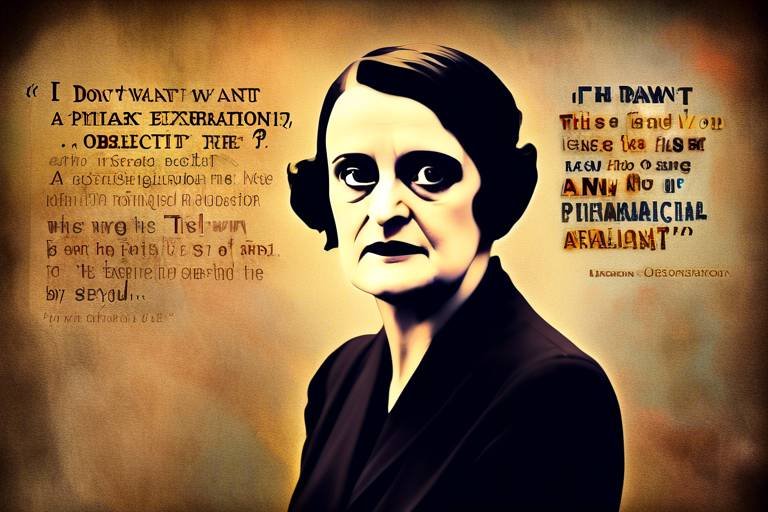The Complexities of the 'Mind-Body Problem'
The relationship between the mind and body has puzzled thinkers for centuries. It’s a captivating enigma that intertwines philosophy, science, and psychology, prompting us to ask profound questions about our existence. What is consciousness? How do our thoughts influence our physical actions? And can we truly separate the mental from the physical? These questions form the crux of the mind-body problem, a complex issue that challenges our understanding of reality itself.
At its core, the mind-body problem addresses the connection between our mental states—thoughts, feelings, and consciousness—and our physical states, which include our bodies and behaviors. Imagine trying to untangle a ball of yarn; the more you pull at one end, the more complicated it becomes. Similarly, the mind and body are intricately linked, but the exact nature of their relationship remains elusive. This article will delve into various perspectives, exploring how different disciplines contribute to our understanding of this age-old dilemma.
To truly grasp the complexities of the mind-body problem, we must first look back at its historical roots. Philosophers like René Descartes laid the groundwork for dualistic thought, proposing that the mind and body are separate entities. His famous dictum, "Cogito, ergo sum" (I think, therefore I am), highlights the significance of thought in defining existence. Yet, as we journey through time, we encounter various theories that challenge and complement these early ideas. From the dualism of Descartes to the physicalism that dominates contemporary thought, the evolution of the mind-body problem reflects our growing understanding of consciousness.
As we navigate through these theories, we will also explore scientific approaches that bridge the gap between the mental and physical realms. Neuroscience, with its focus on the brain's structure and function, provides critical insights into how neural processes correlate with mental experiences. Meanwhile, psychology offers a framework for understanding behavior and cognition, shedding light on how our thoughts and emotions influence our actions.
In the sections that follow, we will unpack these concepts in greater detail, examining the philosophical theories that have shaped our understanding and the scientific discoveries that continue to inform our exploration of the mind-body problem. Buckle up, as we embark on this intellectual journey to unravel one of humanity's most profound mysteries!
- What is the mind-body problem? The mind-body problem is a philosophical and scientific inquiry into the relationship between mental states and physical states.
- Who are the key philosophers associated with the mind-body problem? René Descartes is one of the most prominent figures, known for his dualistic approach, but many others, including John Locke and David Hume, have also contributed significantly.
- How does neuroscience relate to the mind-body problem? Neuroscience explores how brain activity correlates with mental experiences, providing insights into how physical processes influence consciousness.
- Can the mind and body be separated? This is a central question of the mind-body problem, with different theories offering varying perspectives on their relationship.

Historical Perspectives
The mind-body problem has been a captivating enigma throughout human history, weaving its way through the thoughts of philosophers, scientists, and theologians alike. This intricate relationship between our mental states and physical existence has sparked debates that echo through the ages. From the ancient Greeks to contemporary thinkers, the evolution of ideas surrounding the mind and body reflects a quest for understanding that remains relevant today.
In ancient times, philosophers like Socrates and Plato laid the groundwork by suggesting that the mind, or soul, transcends the physical body. Plato famously posited that the soul is immortal and exists in a realm of its own, separate from the corporeal world. This dualistic view set the stage for future discussions, inviting questions that would resonate for centuries.
Fast forward to the 17th century, where René Descartes introduced a more defined dualistic approach. He famously declared, “I think, therefore I am,” emphasizing the distinct separation between the mind and body. Descartes’ dualism posited that the mind is a non-physical entity that interacts with the physical body, a revolutionary idea that sparked further inquiry into the nature of consciousness. His contributions not only influenced philosophy but also laid the groundwork for modern psychology, as he encouraged a systematic approach to understanding human thought and behavior.
As we moved into the 19th century, thinkers like Friedrich Nietzsche and William James began to challenge dualistic notions, advocating for a more integrated view of the mind and body. Nietzsche's concept of the “will to power” suggested that our mental states are deeply influenced by our physical experiences, while James' pragmatism emphasized the interaction between thought and action. These perspectives opened the door to a more holistic understanding of human experience, paving the way for contemporary discussions in psychology and neuroscience.
In the 20th century, the rise of behaviorism further shifted the focus from the mind to observable behavior, as psychologists like B.F. Skinner argued that mental states could be inferred only through actions. This approach sparked a debate about the relevance of internal mental processes, leading to the development of cognitive psychology, which later reintroduced the significance of mental states in understanding human behavior.
Today, the mind-body problem continues to inspire research across various disciplines. Neuroscience, with its technological advancements, has begun to unravel the complexities of how brain activity correlates with mental experiences, providing empirical evidence that both supports and challenges historical perspectives. The ongoing dialogue among philosophers, scientists, and psychologists highlights the rich tapestry of ideas that shape our understanding of consciousness and existence.
In summary, the historical perspectives on the mind-body problem reveal a fascinating evolution of thought. From ancient dualism to modern integrative approaches, the quest to understand the relationship between mind and body is a testament to humanity's enduring curiosity. As we continue to explore this intricate connection, one can only wonder: will we ever fully grasp the depths of our own consciousness?
- What is the mind-body problem? The mind-body problem refers to the philosophical debate regarding the relationship between mental states and physical processes.
- Who were the key philosophers in the history of the mind-body problem? Key philosophers include Socrates, Plato, René Descartes, Friedrich Nietzsche, and William James, each contributing unique perspectives on the issue.
- How has neuroscience influenced our understanding of the mind-body problem? Neuroscience provides empirical evidence on how brain activity correlates with mental states, bridging the gap between physical processes and consciousness.

Philosophical Theories
The mind-body problem has sparked a plethora of philosophical theories, each attempting to unravel the intricate relationship between our mental states and physical existence. As we dive into these theories, we encounter a rich tapestry of ideas that challenge our understanding of consciousness and reality. At the forefront of these discussions are three prominent perspectives: dualism, physicalism, and idealism. Each of these theories offers unique insights and raises profound questions about the very nature of our being.
Dualism stands as a significant contender in the philosophical arena. It suggests that the mind and body are fundamentally different in nature. This theory, most famously championed by René Descartes, posits that while the body is composed of physical substances, the mind exists in a non-physical realm. Imagine a stage where the body is the actor, performing in the physical world, while the mind is the director, orchestrating thoughts and emotions from behind the scenes. This separation raises questions about how these two entities interact, a dilemma that has puzzled philosophers for centuries.
Within dualism, we find two main branches: substance dualism and property dualism. Substance dualism argues that the mind is a distinct, non-physical substance. This view leads to metaphysical debates about the essence of consciousness: Is it something that exists independently of the body? On the other hand, property dualism suggests that although the mind and body are not separate substances, they possess different properties. For instance, mental states can be qualitative and subjective, while physical states adhere to measurable properties. This distinction invites us to ponder how these varied properties influence our understanding of mental experiences.
In stark contrast, physicalism posits that everything, including our thoughts and feelings, can ultimately be explained through physical processes. It argues that mental states are nothing more than brain states, rooted in the biology of our neural networks. Imagine a computer: the hardware (the brain) runs the software (the mind). Physicalists assert that by studying the brain’s structure and function, we can unlock the mysteries of consciousness. However, this perspective faces challenges, particularly in addressing the subjective nature of experiences. Can the richness of human emotion and thought truly be reduced to mere chemical reactions and electrical impulses?
Finally, we encounter idealism, which flips the script entirely. Idealists argue that reality is fundamentally mental, suggesting that the physical world is a construct of our perceptions. This theory raises intriguing questions about the nature of existence: If our minds shape reality, what does that say about the world around us? It invites us to consider the possibility that our experiences are not merely reflections of an external reality, but rather the very fabric of existence itself.
As we explore these philosophical theories, we begin to appreciate the complexity of the mind-body problem. Each perspective offers valuable insights, yet none provide definitive answers. The interplay between mind and body continues to inspire debate and inquiry, pushing the boundaries of our understanding of consciousness. In this ongoing quest for knowledge, we find ourselves navigating a landscape filled with profound questions and tantalizing possibilities.
- What is the mind-body problem?
The mind-body problem is a philosophical dilemma concerning the relationship between mental states and physical processes. - What is dualism?
Dualism is the theory that the mind and body are distinct entities, with the mind being non-physical. - How does physicalism differ from dualism?
Physicalism asserts that everything, including mental states, can be explained in physical terms, whereas dualism maintains a separation between mind and body. - What is idealism?
Idealism posits that reality is fundamentally mental and that the physical world is a construct of our perceptions.

Dualism
Dualism is a fascinating philosophical stance that suggests the mind and body are fundamentally different kinds of substances. Imagine a world where your thoughts and feelings are not just the byproducts of biological processes, but rather exist in a realm entirely separate from the physical. This concept was famously championed by René Descartes, a 17th-century philosopher who posited that the mind (or soul) is immaterial and distinct from the body. For Descartes, the essence of being human lies not in our physical forms but in our capacity for thought, reflection, and consciousness.
This dualistic perspective raises profound questions about the nature of existence. If the mind is separate from the body, how do they interact? How can something non-physical influence physical processes? These questions have puzzled philosophers and scientists alike for centuries. One way to approach this dilemma is through the lens of substance dualism and property dualism, two subcategories of dualistic thought that offer different insights into the mind-body relationship.
Substance dualism argues that the mind is a non-physical substance that exists independently of the body. This theory posits that while our bodies are made up of matter and governed by physical laws, our minds operate in a separate realm. Think of it like a computer: the hardware (body) and software (mind) can exist independently, yet they work together to produce a functional system. Descartes famously stated, “I think, therefore I am,” suggesting that the very act of thinking is proof of the mind's existence, separate from the physical body.
On the other hand, property dualism suggests that the mind and body are not separate substances but rather possess different properties. This perspective maintains that while mental states arise from physical processes, they exhibit qualities that cannot be fully explained by physical science alone. For example, consider the experience of pain. While pain has a physiological basis, the subjective experience of it—how it feels—cannot be reduced to mere neural activity. This idea challenges us to think about the complexities of mental states and their relationship to our physical bodies.
In summary, dualism invites us to explore the depths of our consciousness and the nature of reality. It raises essential queries about identity, existence, and the intricate dance between our minds and bodies. As we delve deeper into this philosophical framework, we begin to understand not only the complexities of human experience but also the profound implications for fields like psychology and neuroscience.
- What is dualism? Dualism is the philosophical view that the mind and body are distinct entities, with the mind being non-physical and the body being physical.
- Who is the most famous proponent of dualism? René Descartes is the most notable philosopher associated with dualism, particularly through his concept of substance dualism.
- What are the two main types of dualism? The two main types are substance dualism, which posits that the mind is a separate substance, and property dualism, which argues that while the mind and body are not separate substances, they have different properties.
- How does dualism relate to modern science? Dualism raises questions about the interaction between the mind and body, which are still being explored in neuroscience and psychology today.

Substance Dualism
Substance dualism, a concept famously championed by the philosopher René Descartes, posits that the mind and body are fundamentally different in nature. This perspective suggests that while our bodies are made up of physical substances that can be studied and measured, the mind exists as a non-physical entity, separate from the corporeal realm. Imagine the mind as a ghostly figure, floating above the tangible body, directing its actions without being confined by physical limitations. This idea has sparked numerous debates and discussions in both philosophical and scientific circles.
One of the most compelling aspects of substance dualism is its ability to address certain questions about consciousness that physicalist approaches struggle with. For instance, if everything about our mental life can be explained through physical processes, what accounts for the subjective experience of emotions, thoughts, and sensations? This is often referred to as the "hard problem" of consciousness. Substance dualism offers a framework where the mind's non-physical nature allows for these rich, qualitative experiences to exist beyond mere biological functions.
However, substance dualism is not without its critics. Many argue that separating the mind from the body creates more problems than it solves. For instance, if the mind is a separate entity, how does it interact with the body? This leads to what is known as the interaction problem. Critics suggest that if the mind can influence physical actions, such as deciding to raise an arm, then there must be some form of communication or interaction between the two, which is difficult to explain under a dualistic framework.
Despite these challenges, substance dualism has had a lasting influence on various fields, from psychology to neuroscience. It encourages a deeper exploration of the nature of consciousness and has led to numerous philosophical inquiries. For example, consider the implications of substance dualism in understanding mental disorders. If the mind is a separate substance, how do we account for changes in mental states due to physical conditions, such as brain injuries or chemical imbalances? This complexity adds layers to our understanding of both mental health and the treatment of psychological conditions.
In conclusion, substance dualism presents a fascinating yet contentious viewpoint on the mind-body relationship. By asserting the existence of a non-physical mind, it opens up a plethora of questions about consciousness, identity, and the essence of being. While it may not provide all the answers, it undeniably enriches the ongoing dialogue about what it means to be human, merging the realms of philosophy, science, and personal experience.
- What is substance dualism? - Substance dualism is the philosophical view that the mind and body are distinct entities, with the mind being a non-physical substance.
- Who is the main proponent of substance dualism? - René Descartes is the most notable philosopher associated with substance dualism.
- What are the main criticisms of substance dualism? - Critics argue that it leads to the interaction problem, questioning how a non-physical mind can influence a physical body.
- How does substance dualism relate to modern psychology? - It influences discussions about the nature of consciousness and the treatment of mental health conditions.

Property Dualism
Property dualism presents a fascinating perspective on the mind-body problem, suggesting that while the mind and body are not separate substances, they possess distinctly different properties. This view diverges from substance dualism, which posits that the mind exists as a non-physical entity, separate from the physical body. Instead, property dualism emphasizes the idea that both the mind and body coexist as part of the same substance but exhibit different characteristics that cannot be easily reconciled. It’s akin to how a single piece of fruit can have both a sweet taste and a rough texture; they are part of the same fruit yet represent different qualities.
One of the significant implications of property dualism is its challenge to reductionist views that attempt to explain mental states solely in terms of physical processes. For instance, think about emotions; they are deeply felt experiences that influence our behavior and thoughts, yet they cannot be fully captured by examining brain chemistry alone. Property dualism allows for the acknowledgment that mental states, such as feelings and thoughts, have unique properties that require a different lens for understanding.
To illustrate the distinction between mental and physical properties, consider the following table:
| Aspect | Mental Properties | Physical Properties |
|---|---|---|
| Nature | Qualitative experiences (e.g., emotions, thoughts) | Quantitative measurements (e.g., brain activity) |
| Perception | Subjective and personal | Objective and measurable |
| Interaction | Influences behavior and decision-making | Observable through scientific methods |
In essence, property dualism invites us to explore the rich tapestry of human experience, recognizing that our mental lives are not merely byproducts of brain activity but are integral to our existence. This perspective encourages a more holistic approach to understanding consciousness, one that respects the complexity of our thoughts and feelings as essential components of what it means to be human.
Moreover, property dualism has significant implications for fields such as psychology and neuroscience, as it suggests that understanding consciousness requires more than just a biological explanation. It opens the door to exploring how our mental states can influence our physical actions and vice versa, creating a dynamic interplay between mind and body that enriches our understanding of human behavior.
Ultimately, property dualism challenges us to consider the intricacies of our mental experiences and their relationship with our physical selves. It proposes that to truly grasp the essence of consciousness, we must embrace the complexities that lie within the intersection of mental and physical properties, acknowledging that both play vital roles in shaping our reality.
- What is property dualism? Property dualism is the philosophical view that while the mind and body are not separate substances, they have different properties that cannot be fully explained by physical processes alone.
- How does property dualism differ from substance dualism? Substance dualism posits that the mind exists as a separate, non-physical entity, while property dualism argues that the mind and body are part of the same substance but exhibit different characteristics.
- What implications does property dualism have for psychology? Property dualism suggests that understanding mental states requires consideration of both psychological and physical processes, highlighting the complexity of human experience.

Physicalism
Physicalism is a compelling philosophical stance that asserts everything in existence, including our thoughts, emotions, and consciousness, can be explained in purely physical terms. Imagine a world where every flicker of thought and every wave of emotion can be mapped onto the physical workings of the brain. This perspective challenges us to rethink our understanding of the mind-body relationship, suggesting that mental states are not separate from physical states but rather emerge from them. It’s like trying to understand a beautiful symphony; while the music is enchanting, it’s the instruments and notes that create it, grounding the beauty in something tangible.
Advocates of physicalism argue that as our scientific knowledge advances, particularly in neuroscience, we are increasingly able to explain complex mental phenomena in terms of brain activity. For instance, when we experience joy, it’s not just an abstract feeling; it corresponds to specific neural pathways firing in our brains. This leads to the idea that consciousness is not an ethereal entity but rather a product of physical processes. However, this perspective does face challenges, particularly when addressing subjective experiences, known as qualia. How can something as rich and unique as the experience of color or the taste of chocolate be fully explained by neurons firing?
To better understand physicalism, let’s explore some key arguments in favor of this view:
- Scientific Evidence: Advances in neuroscience have shown correlations between brain states and mental states, suggesting that understanding the brain could lead to a complete understanding of consciousness.
- Parsimony: Physicalism adheres to the principle of Occam's Razor, which posits that the simplest explanation is often the correct one. By explaining everything in physical terms, we avoid introducing unnecessary metaphysical entities.
- Predictive Power: Physicalist theories often have predictive capabilities, allowing scientists to anticipate how changes in the brain can affect behavior and experience.
Despite its strengths, physicalism encounters significant philosophical challenges. Critics argue that it fails to account for the subjective nature of experiences. For example, when we discuss the color red, we can describe the wavelengths of light associated with it, but we cannot fully convey the experience of seeing red to someone who has never seen it. This raises questions about whether physicalism can truly encompass the richness of human experience.
Moreover, the debate between physicalism and dualism remains heated. Dualists argue that there is more to the mind than just physical processes, suggesting an immaterial aspect that cannot be fully explained by science. This philosophical tug-of-war invites us to ponder deeper questions about the nature of reality, consciousness, and our very existence.
In summary, while physicalism provides a robust framework for understanding the mind-body problem, it also opens the door to further inquiry and debate. As we continue to explore the intricate relationship between physical processes and mental states, we may find ourselves on a path that leads to greater understanding, not just of the mind, but of what it means to be human.
What is physicalism?
Physicalism is the philosophical view that everything, including mental states, can be explained in terms of physical processes and properties.
How does physicalism relate to neuroscience?
Physicalism aligns with neuroscience by suggesting that our mental experiences correspond to brain activity, meaning that understanding the brain could lead to a better understanding of consciousness.
What are the main criticisms of physicalism?
Critics argue that physicalism cannot fully account for subjective experiences (qualia) and that it may overlook the complexities of consciousness that cannot be reduced to mere physical explanations.

Scientific Approaches
The mind-body problem has captivated scientists and philosophers alike, leading to a multitude of inquiries about how our mental states relate to our physical existence. In recent decades, the fields of neuroscience and psychology have made significant strides in unraveling this complex relationship. By employing cutting-edge technologies and innovative research methodologies, scientists are beginning to bridge the elusive gap between the brain's physical processes and our subjective experiences. But how do these scientific approaches help us understand the mind-body problem?
Neuroscience, for instance, has become a powerful tool in exploring the intricate connections between brain activity and mental states. Researchers utilize techniques such as functional magnetic resonance imaging (fMRI) and electroencephalography (EEG) to observe real-time brain activity. These methods allow scientists to identify which areas of the brain are activated during specific cognitive tasks, revealing fascinating insights into how thoughts, emotions, and perceptions manifest in our neural circuitry. For example, studies have shown that different emotional responses correlate with distinct patterns of brain activation, suggesting that our feelings are deeply rooted in physical processes.
Moreover, the exploration of neuroplasticity—the brain's ability to reorganize itself by forming new neural connections—further emphasizes the dynamic interplay between mind and body. This concept implies that our experiences, thoughts, and behaviors can physically alter the structure of our brains. In a way, it’s as if our minds are sculptors, continually shaping the very material of our being. This revelation raises intriguing questions: Can changing our thoughts change our brains? And if so, how does this transformation impact our conscious experience?
Psychology also plays a crucial role in deciphering the mind-body connection. Various psychological theories provide frameworks for understanding how our thoughts and behaviors influence our physical health and well-being. For instance, cognitive-behavioral therapy (CBT) emphasizes the relationship between our thoughts, feelings, and behaviors, asserting that changing negative thought patterns can lead to improved emotional and physical health. This approach highlights how our mental processes can directly affect bodily functions, illustrating the profound interconnectedness of mind and body.
Furthermore, research in psychoneuroimmunology is shedding light on how psychological factors can influence immune responses. Studies have demonstrated that stress and emotional states can significantly affect our immune system's functioning, suggesting that our mental well-being is intricately linked to our physical health. This relationship is akin to a complex dance, where the mind leads the body in a choreography of interactions that affect our overall health.
To summarize, the scientific approaches to the mind-body problem reveal a rich tapestry of interactions between our mental and physical selves. Neuroscience provides insights into the brain's role in shaping consciousness, while psychology offers frameworks for understanding the implications of our thoughts and behaviors on our physical health. Together, these fields contribute to a more nuanced understanding of the mind-body relationship, highlighting the importance of considering both aspects in our quest for knowledge.
- What is the mind-body problem? The mind-body problem explores the relationship between mental states (thoughts, feelings) and physical states (brain activity, bodily functions).
- How does neuroscience contribute to understanding the mind-body problem? Neuroscience uses technologies like fMRI and EEG to study brain activity and its link to mental states, providing insights into how our thoughts and emotions are rooted in physical processes.
- What role does psychology play in this discussion? Psychology examines how our thoughts and behaviors influence our physical health, offering frameworks like cognitive-behavioral therapy to illustrate the connection between mental and physical well-being.

Neuroscience Insights
Neuroscience has revolutionized our understanding of the mind-body relationship by providing empirical evidence that bridges the gap between mental experiences and physical processes. The brain, once viewed merely as a biological organ, is now recognized as the epicenter of our consciousness, emotions, and thoughts. This shift in perspective has profound implications for how we understand ourselves and our interactions with the world around us.
Recent studies have shown that specific neural pathways are associated with various mental states. For instance, when we experience emotions like joy or sadness, particular regions of the brain become active. This has led researchers to conclude that our feelings are not just ephemeral experiences but are rooted in the physical structure of our brain. A key player here is the prefrontal cortex, which is involved in decision-making and emotional regulation. It's fascinating to think that the very essence of who we are—our thoughts and feelings—can be traced back to the firing of neurons in this complex organ.
Moreover, the advent of advanced imaging technologies, such as functional MRI (fMRI) and electroencephalography (EEG), has allowed scientists to observe the brain in action. These tools have illuminated how different regions of the brain communicate and collaborate to produce what we experience as consciousness. For example, when someone recalls a memory, the hippocampus is activated, which then interacts with the prefrontal cortex to retrieve and reconstruct that memory. This intricate dance of neural activity underscores the idea that our mental processes are deeply intertwined with physical brain functions.
One particularly intriguing area of research is the role of neurotransmitters—chemical messengers that transmit signals between neurons. The balance of these chemicals can significantly affect our mental state. For example, low levels of serotonin are often linked to depression, while increased levels can enhance mood. Understanding these biochemical pathways not only sheds light on mental health disorders but also opens doors for potential treatments that target these specific pathways.
Additionally, the concept of neuroplasticity has emerged as a groundbreaking insight in neuroscience. This refers to the brain's ability to reorganize itself by forming new neural connections throughout life. Neuroplasticity demonstrates that our experiences and environments can physically alter the brain's structure. For instance, learning a new skill or overcoming trauma can lead to significant changes in brain connectivity, suggesting that our mental states are not fixed but can evolve based on our interactions and experiences.
As we delve deeper into the complexities of the mind-body problem, it becomes evident that neuroscience provides a critical framework for understanding the intricate relationship between our physical selves and our conscious experiences. The findings from this field not only challenge traditional philosophical notions but also offer hope for therapeutic interventions that can enhance mental well-being.
- What is the mind-body problem? The mind-body problem explores the relationship between consciousness (the mind) and the physical body, questioning how they interact and influence each other.
- How does neuroscience contribute to understanding consciousness? Neuroscience offers insights into how brain activity correlates with mental states, revealing the biological underpinnings of consciousness.
- What is neuroplasticity? Neuroplasticity is the brain's ability to change and adapt in response to experiences, suggesting that our mental states can be influenced by our actions and environment.
- Can neuroscience explain all aspects of consciousness? While neuroscience has made significant strides, consciousness remains a complex phenomenon that may not be fully explained by biological processes alone.

Psychological Perspectives
The relationship between the mind and body is not just a philosophical quandary; it is also a vibrant field of inquiry within psychology. Understanding how our mental processes influence our physical state—and vice versa—can illuminate the complexities of human behavior. Have you ever felt anxious before a big presentation, only to notice your heart racing and palms sweating? This is a classic example of how our mental state can trigger physical reactions. In psychology, this interconnection is explored through various theories that seek to unravel the intricate web of the mind-body relationship.
One of the most significant frameworks in psychology is the biopsychosocial model, which posits that biological, psychological, and social factors all play a crucial role in human functioning. This model emphasizes that mental health cannot be understood in isolation but must consider the interplay of various influences. For instance, consider how stress (a psychological factor) can lead to physical ailments such as headaches or stomach problems. This model illustrates that our thoughts and feelings are not just abstract concepts; they have tangible effects on our physical well-being.
Moreover, cognitive-behavioral therapy (CBT) exemplifies the practical application of psychological perspectives on the mind-body connection. CBT operates on the premise that our thoughts influence our emotions and behaviors. By altering negative thought patterns, individuals can experience significant changes in their emotional and physical states. For example, someone who constantly thinks they will fail may experience anxiety that manifests in physical symptoms like nausea. By addressing these thoughts, CBT can help alleviate both the mental distress and its physical repercussions.
Additionally, the field of psychoneuroimmunology has emerged, which studies the interaction between psychological processes and the nervous and immune systems. Research in this area has shown that stress and emotional states can significantly impact immune function. For instance, chronic stress can weaken the immune response, making individuals more susceptible to illnesses. This connection highlights the importance of mental health in maintaining physical health and vice versa.
Incorporating mindfulness and meditation into psychological practices also emphasizes the mind-body relationship. Mindfulness encourages individuals to become aware of their thoughts and feelings without judgment, fostering a deeper connection to their physical sensations. This practice has been shown to reduce stress, improve emotional regulation, and enhance overall well-being. Have you ever noticed how taking a moment to breathe deeply can calm your racing thoughts? That’s the power of mindfulness at work, bridging the gap between mental clarity and physical relaxation.
In summary, psychological perspectives offer valuable insights into the mind-body problem by illustrating how our thoughts, emotions, and social contexts influence our physical health. As we continue to explore these connections, it becomes increasingly clear that understanding the mind-body relationship is essential for promoting holistic well-being. By embracing this complexity, we can better address mental health issues and improve our overall quality of life.
- What is the mind-body problem? The mind-body problem explores the relationship between mental processes and physical states, questioning how they interact and influence each other.
- How does psychology contribute to understanding the mind-body problem? Psychology provides frameworks and theories, such as the biopsychosocial model and cognitive-behavioral therapy, to explore the interplay between mental and physical health.
- What role does stress play in the mind-body connection? Stress can lead to physical symptoms and health issues, highlighting the importance of managing mental states for overall well-being.
- Can mindfulness improve the mind-body connection? Yes, mindfulness practices help individuals become more aware of their thoughts and feelings, promoting better emotional regulation and physical relaxation.
Frequently Asked Questions
- What is the mind-body problem?
The mind-body problem is a philosophical question that explores the relationship between the mind (consciousness) and the body (physical existence). It raises fundamental questions about how mental states, such as thoughts and emotions, relate to physical processes in the brain and body.
- Who were the key philosophers that contributed to the mind-body problem?
Throughout history, several philosophers have significantly influenced the mind-body problem. Notable figures include René Descartes, who introduced dualism, and John Locke, who contributed to discussions on consciousness and personal identity. Their ideas have shaped the way we think about the connection between mind and body.
- What is dualism?
Dualism is the philosophical view that the mind and body are fundamentally distinct entities. This perspective suggests that the mind exists independently of the physical body, leading to various implications for understanding consciousness and reality.
- What are the differences between substance dualism and property dualism?
Substance dualism posits that the mind is a non-physical substance separate from the body, while property dualism argues that although the mind and body are not separate substances, they possess different properties. This distinction influences how we approach mental states and their relationship to physical processes.
- What is physicalism?
Physicalism is the view that everything, including mental states, can be explained in physical terms. It suggests that all phenomena, including consciousness, arise from physical processes in the brain, challenging the notion of a separate mental realm.
- How does neuroscience contribute to understanding the mind-body problem?
Neuroscience provides insights into how brain activity correlates with mental states. Research in this field has uncovered connections between neural processes and consciousness, helping to bridge the gap between physical and mental experiences.
- What role does psychology play in the mind-body interaction?
Psychology offers frameworks for understanding the complexities of mental processes and behavior. It explores how cognitive functions, emotions, and behaviors interact with physical states, providing valuable perspectives on the mind-body relationship.



















